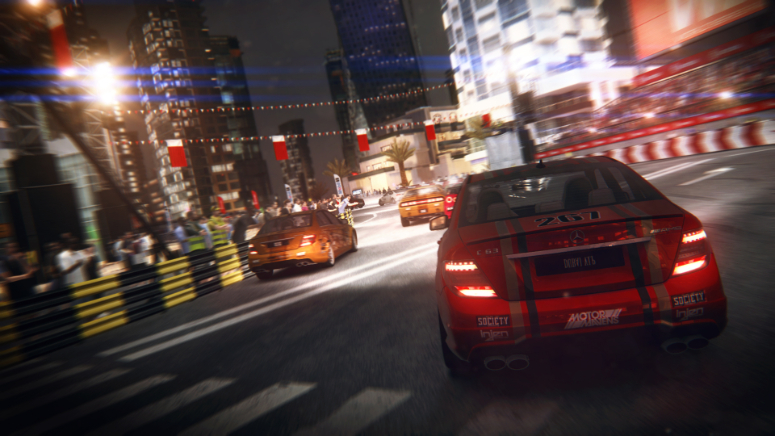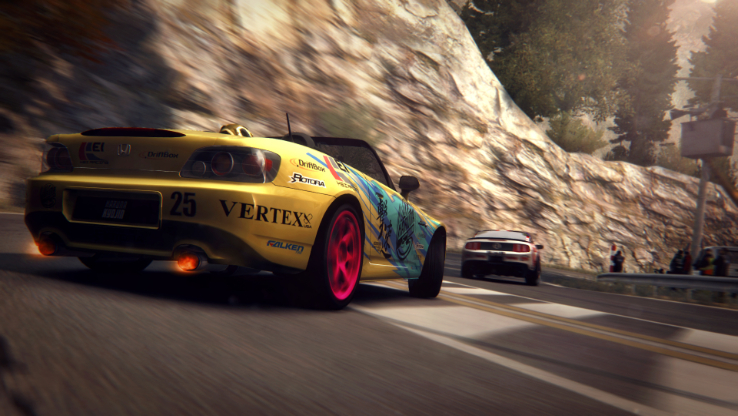Finally – it’s arrived. The sequel to Codemasters original track racing series – GRID. GRID was released in 2008 to much critical acclaim (SEGA even made an arcade version – something of a rarity these days!) and was very popular with racing fans, and casual players too. Now it’s 2013 – GRID 2 is finally out, but have Codemasters managed to make a sequel worthy of such a long wait?
 The story of GRID 2’s single-player campaign is simple. You start off by being thrown straight into a race to prove your worth. You get noticed by a hot-shot who wants to make you the face of his new racing competition – the WSR. Your goal is to make the WSR world-famous, by driving various events and bringing attention to the competition all across the world. There are tracks ranging from California all the way to Japan, with each region having its own selection of events. Once you have competed in the events, you win fans. Fans appear to be your measure of progress, and the more fans you have, the more events you unlock.
The story of GRID 2’s single-player campaign is simple. You start off by being thrown straight into a race to prove your worth. You get noticed by a hot-shot who wants to make you the face of his new racing competition – the WSR. Your goal is to make the WSR world-famous, by driving various events and bringing attention to the competition all across the world. There are tracks ranging from California all the way to Japan, with each region having its own selection of events. Once you have competed in the events, you win fans. Fans appear to be your measure of progress, and the more fans you have, the more events you unlock.
The events in GRID 2 are varied and fun, with some more unusual event types like togue – racing along a track with an opponent right next to you, any form of contact and you’re disqualified. There are also checkpoint races which are clearly a nod to old arcade racers of the past (Sega Rally anyone?) where you have a short time limit, and travelling through a checkpoint tops up your time by a few seconds. The other events are standard for the GRID series, drift, circuit and point to point races. However, one feature that’s been really talked about is the introduction of ‘Live routes’. Races on live routes are completely dynamic and change as you race. You never know what is going to be around the corner, and sometimes it can be pretty disorienting. This kind of race isn’t really new, as games like Motorstorm and Split Second have always had features like this, but GRID 2 manages to make it still feel like a proper race. Another interesting side effect that this brings is that no driver – however experienced, can ever learn the racing line for the track. This gives all players a level playing field, especially for online races on these tracks.
 One of the things that really made the original GRID stand out was the balance that was struck between simulated racing and arcade racing. Codemasters managed to get it right on the first game, and GRID 2 is even more improved. The handling is quite forgiving, with drifts easy to control. There is still enough difficulty in the driving so that the game feels like a simulator. The cars are now assigned a category – ‘Drift’, ‘Balanced’ or ‘Grip’. For the most part, you are free to choose any one of these cars and each one is more suited to each different event. For example, a drift car is perfect for drift or togue events. Unfortunately, there are no modifications for you to do to the cars – in single-player mode at least. Instead, you win cars by doing promotional events and winning races. When you win a car, you often get a choice of two cars – both with pretty similar performance. The one you don’t pick later becomes a car you can win in a time trial, so you’ll always end up with both in the end.
One of the things that really made the original GRID stand out was the balance that was struck between simulated racing and arcade racing. Codemasters managed to get it right on the first game, and GRID 2 is even more improved. The handling is quite forgiving, with drifts easy to control. There is still enough difficulty in the driving so that the game feels like a simulator. The cars are now assigned a category – ‘Drift’, ‘Balanced’ or ‘Grip’. For the most part, you are free to choose any one of these cars and each one is more suited to each different event. For example, a drift car is perfect for drift or togue events. Unfortunately, there are no modifications for you to do to the cars – in single-player mode at least. Instead, you win cars by doing promotional events and winning races. When you win a car, you often get a choice of two cars – both with pretty similar performance. The one you don’t pick later becomes a car you can win in a time trial, so you’ll always end up with both in the end.
Multiplayer was somewhat lacking in the first GRID, but thankfully Codemasters decided to make the online mode in GRID 2 more like a completely separate game rather than tacking it on as an afterthought. This really gives the game extra value, and far more replayability – something extremely important these days. Cars can be purchased and upgraded in multiplayer mode by using the currency you earn from winning racing. There are lots more modes to choose from too, including one where contact is turned off completely. This lets you race against the more tame and careful drivers in the GRID community. It’s still pretty fun and satisfying to smash into other drivers ‘accidentally’ to help yourself around corners in normal races though!
 Codemasters has a knack for making good looking games, and GRID 2 is no exception. However, the quality of graphics in its predecessor set the bar pretty high. There’s only so far you can go before the difference starts looking minimal. GRID 2 manages to bump up the graphics quality a bit from the original grid, but definitely not 5 years’ worth of improvements. Thankfully the damage is still as detailed as ever and any knock or crash will show up on your car. The menu system stands out too, as it always does from Codemasters games, and looks absolutely beautiful. The location of the menu also changes depending on how far you’ve progressed. A nice little detail. There is one rather odd omission that’s been made from GRID 2. The complete lack of an in-car cockpit view. This seems like something that’s taken for granted in modern racing games, and almost every racing game that takes it seriously has this feature. Without it, GRID 2 loses some of its immersion, especially when playing with a racing wheel.
Codemasters has a knack for making good looking games, and GRID 2 is no exception. However, the quality of graphics in its predecessor set the bar pretty high. There’s only so far you can go before the difference starts looking minimal. GRID 2 manages to bump up the graphics quality a bit from the original grid, but definitely not 5 years’ worth of improvements. Thankfully the damage is still as detailed as ever and any knock or crash will show up on your car. The menu system stands out too, as it always does from Codemasters games, and looks absolutely beautiful. The location of the menu also changes depending on how far you’ve progressed. A nice little detail. There is one rather odd omission that’s been made from GRID 2. The complete lack of an in-car cockpit view. This seems like something that’s taken for granted in modern racing games, and almost every racing game that takes it seriously has this feature. Without it, GRID 2 loses some of its immersion, especially when playing with a racing wheel.
When playing GRID 2 it’s easy to see all of the improvements, but it’s also easy to see what’s missing. The whole WSR arrangement is nice but still feels a little limited compared to games like Forza and Gran Turismo 5. The inability to upgrade and buy cars in single player mode also seems like a massive gap, it’d be far better to be there than multiplayer. And a missing dash view is almost unforgivable as it’s a step back from the first game. I expected more for a game that’s supposedly been in development for 5 years. All that aside, I really enjoyed GRID 2. The handling has been perfected and the cars are so much fun to drive. Add to that an absolutely huge online mode that is a game in itself and you’ve got a game that is worth buying for any casual or even hardcore fan.
Written by Nick Bedford
Enjoy the review? want to read more of our reviews? then click right here to be whisked away to the realm of our opinions.








You must be logged in to post a comment.